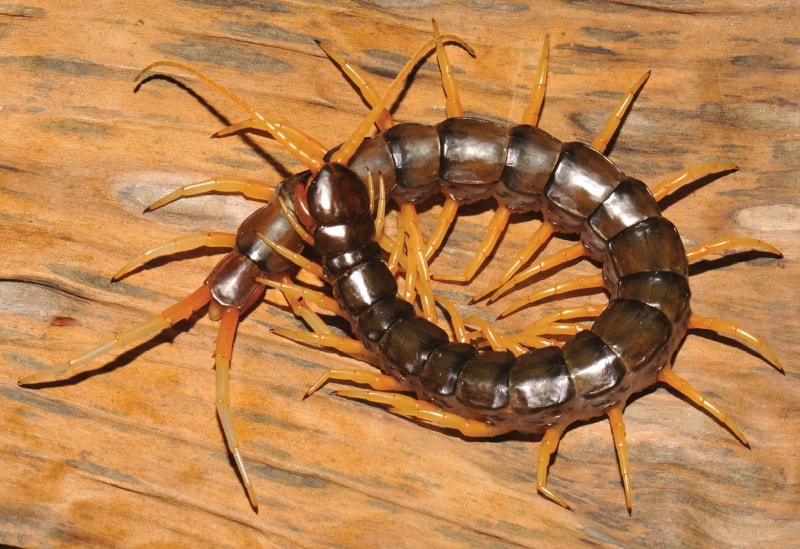
Aquatic Centipede Facts
- This evocative creation of natural evolution most frequently goes by the informative common name of the Aquatic Centipede. It’s also referred to as the waterfall centipede. For the moment, the intriguing animal has no other accepted general name.
- Within scientific circles, though, it’s typically much better known by its technical name. That’s a somewhat difficult to pronounce name, however, at least for laymen. That’s because the invertebrate bears the formal moniker of the Scolopendra cataracta.
- It received that name, in part, due to the efforts of the British researcher, Gregory Edgecombe. He, along with his student, Warut Siriwut, and another individual, accomplished the first recognition of it as a separate species. This occurred in 2016.
- Regardless of the term one chooses to use when referring to it, it’s a remarkable species. It’s also somewhat mysterious. To date, only four confirmed specimens of the species exist. It’s presently undetermined whether it’s extremely rare or simply rarely seen.
- Due to this undetermined status, the IUCN currently has no listing for the Aquatic Centipede at this time. Investigations and research remain ongoing, however. Once its status is confirmed, that will be reflected on the organization’s published Red List.
- Obviously, no data exists for now regarding confirmed threats to its existence as a species. Given its habitat, though, several situations could qualify in that regard. Habitat degradation poses a potential threat. Climate change also does so, as for most species.
Related Articles
Aquatic Centipede Physical Description
The remarkable Aquatic Centipede quickly fascinated those who originally encountered it, and realized it was a new species. That also occurred due to a variety of other reasons, of course. The sheer physical size of this Arthropod certainly ranks as one of those factors.
That holds true due to the fact that it qualifies as a giant of its kind. The few individuals known to date attained a body length measuring approximately 7.9 in (20 cm). Being so rare, it still remains unknown, however, if this represents the maximum growth of the species.
It’s also unknown, therefore, whether or not it displays any degree of the physiological characteristic of sexual dimorphism. Most of its relatives do display a slight degree of this gender-based difference. It’s thus likely, though by no means certain, that it does also.
The body of this amazing animal clearly develops as highly elongated, as typical of its kind. This further presents the same segmented structure so representative of all known centipedes. The body of the species itself manifests a striking greenish-black shade.
The legs of the fascinating Aquatic Centipede also garner a certain amount of notice, as well. Though not actually totaling 100 in number, as the name implies, it still has quite a lot of them! These appendages also present a distinctive pale yellowish-orange in color.
- Kingdom: Animalia
- Phylum: Arthropoda
- Class: Chilopoda
- Order: Scolopendromorpha
- Family: Scolopendridae
- Genus: Scolopendra
- Species: S. cataracta
Aquatic Centipede Distribution, Habitat, and Ecology
For the moment, the full extent of the zone of habitation of the baffling Aquatic Centipede remains undetermined. The four individual specimens known, however, appeared within a region of the globe renowned for its wonders. That region likely comes as no surprise.
That’s due to the fact that the known members of the species were found in three places in Southeast Asia. More specifically, they lived in the countries of Thailand, Laos, and Vietnam. Understandably, it’s still unknown if it lives, or ever lived, beyond these areas of the globe.
Yet the most astounding fact about this wonder of Nature has nothing to do with its simple physical characteristics or location. Indeed, it distinguishes itself from every other known variety of centipede in the world in a unique way. As its name implies, it’s an aquatic species!
More precisely,this creation of natural processes evolved as amphibious. In the grand scheme, it seems to make its home only in dense forests. Every one found so far appeared close to streams. It seems to be equally at home in the water, where it swims like an eel.
Given the lack of study, no certain knowledge of the ecology of the Aquatic Centipede exists. Theories, however, propose that it may have a nocturnal behavioral pattern. Other theories suggest that it evolved to prey on small invertebrates, both on land and in the water.
Species Sharing Its Range
Check out our other articles on 5 Beautiful Birds of Venezuela, Grizzled Giant Squirrel, European Honey Buzzard, Vintgar Gorge, Smooth Purple Coneflower, Black Mamba, Snowflake Moray
